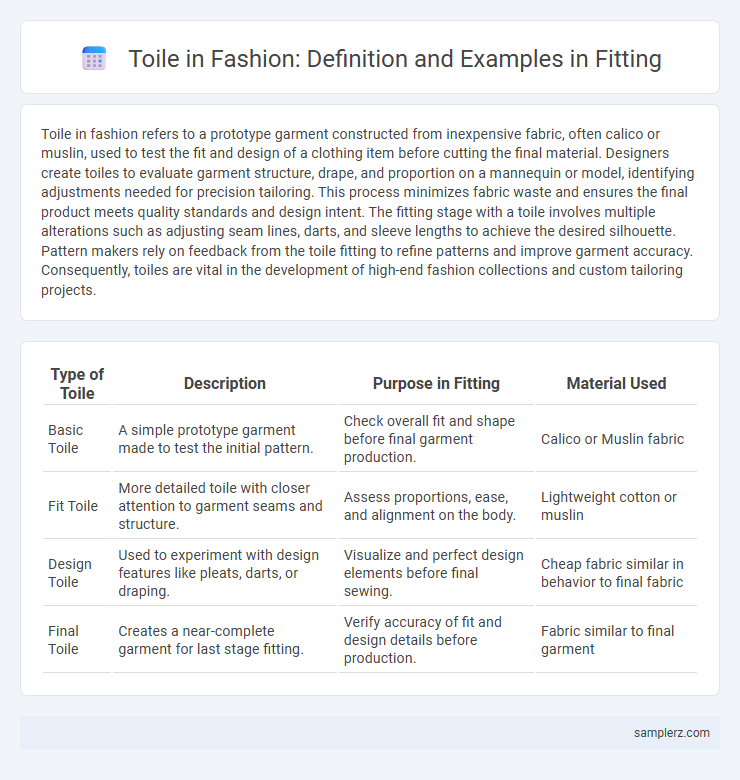Toile in fashion refers to a prototype garment constructed from inexpensive fabric, often calico or muslin, used to test the fit and design of a clothing item before cutting the final material. Designers create toiles to evaluate garment structure, drape, and proportion on a mannequin or model, identifying adjustments needed for precision tailoring. This process minimizes fabric waste and ensures the final product meets quality standards and design intent. The fitting stage with a toile involves multiple alterations such as adjusting seam lines, darts, and sleeve lengths to achieve the desired silhouette. Pattern makers rely on feedback from the toile fitting to refine patterns and improve garment accuracy. Consequently, toiles are vital in the development of high-end fashion collections and custom tailoring projects.
Table of Comparison
| Type of Toile | Description | Purpose in Fitting | Material Used |
|---|---|---|---|
| Basic Toile | A simple prototype garment made to test the initial pattern. | Check overall fit and shape before final garment production. | Calico or Muslin fabric |
| Fit Toile | More detailed toile with closer attention to garment seams and structure. | Assess proportions, ease, and alignment on the body. | Lightweight cotton or muslin |
| Design Toile | Used to experiment with design features like pleats, darts, or draping. | Visualize and perfect design elements before final sewing. | Cheap fabric similar in behavior to final fabric |
| Final Toile | Creates a near-complete garment for last stage fitting. | Verify accuracy of fit and design details before production. | Fabric similar to final garment |
Understanding Toile: Key Concepts in Fashion Fitting
Toile, a crucial tool in fashion fitting, serves as a prototype garment made from inexpensive fabric to test the pattern and fit before final production. This process allows designers to assess proportions, adjust darts, seams, and ease, ensuring the garment contours perfectly to the body shape. Mastery of toile fitting reduces costly alterations and enhances precision in achieving desired silhouettes for various fashion designs.
Historical Significance of Toile in Garment Creation
Toile, traditionally a simple muslin fabric used in garment fitting, holds historical significance as a critical step in fashion design for centuries. Originating in 18th-century France, it enabled designers to perfect garment shapes before cutting luxurious fabrics, preserving expensive materials and aligning with couture craftsmanship. This practice remains essential in modern haute couture, reflecting an enduring legacy of precision and creative innovation in fashion construction.
Types of Toile Used in Fitting Sessions
Toiles used in fitting sessions vary from basic muslin to more structured cotton blends, each serving distinct purposes in garment construction. Muslin toiles offer a lightweight, inexpensive option ideal for initial draping and pattern adjustments, while heavier cotton or linen toiles simulate the garment's final fabric behavior for more precise fitting. Designers often select stretch or woven fabric toiles depending on the garment's design requirements and intended fabric characteristics.
Step-by-Step Toile Fitting Process Explained
The toile fitting process begins with creating a basic garment prototype from inexpensive fabric to evaluate fit and design accuracy. Next, the toile is pinned and adjusted directly on the model or dress form, identifying issues such as tightness, uneven hems, or misaligned seams. Final steps include marking alterations on the toile, transferring changes to the pattern, and refining the fit before cutting the final fabric.
Common Fabrics for Creating a Toile Mockup
Common fabrics for creating a toile mockup include calico, muslin, and broadcloth, as these materials are affordable, lightweight, and closely mimic garment drape. Calico is preferred for its durability and easy handling during fitting adjustments, while muslin offers a soft texture that enhances pattern accuracy. Broadcloth provides a smooth surface ideal for detailed stitching, making these fabrics essential in the fitting process to perfect garment design before cutting into expensive textiles.
Benefits of Using Toile During Pattern Adjustments
Using toile during pattern adjustments allows designers to visualize garment fit and make precise alterations before cutting into expensive fabric, minimizing material waste and costs. Toile provides an accurate three-dimensional prototype, helping identify fit issues such as ease, seam alignment, and proportion in real-time. This process enhances design accuracy, reduces production errors, and ensures a higher-quality final garment tailored to exact measurements.
Designer Insights: Toile’s Role in Couture Fittings
Toiles serve as crucial prototypes in couture fittings, allowing designers to refine garment structure and ensure precise tailoring before final fabric cutting. This preliminary model, often crafted from muslin, provides essential feedback on silhouette, drape, and fit, helping designers perfect their vision. By meticulously adjusting the toile, fashion houses achieve impeccable craftsmanship and elevate the final couture piece's quality and wearability.
Real-World Examples of Toile in Fashion Houses
Maison Margiela meticulously uses toile fittings to refine the silhouette and structure of avant-garde garments before final production. At Dior, toiles serve as essential prototypes, allowing designers to perfect fit and drape on muslin fabric, ensuring luxury garments meet haute couture standards. Alexander McQueen's atelier relies on toiles to experiment with complex patterns and bold shapes, embodying innovation and precision in the final collections.
Mistakes to Avoid When Working with Toile
Common mistakes to avoid when working with toile include using inappropriate fabric that lacks structure, leading to poor drape and inaccurate fitting results. Neglecting precise seam allowances and pattern markings can cause fitting errors and distort the garment's shape during adjustments. Failing to test and refine toile on a fit model before finalizing patterns often results in time-consuming alterations and compromised garment quality.
Advancements in Toile Techniques for Modern Fitting
Advancements in toile techniques for modern fitting have revolutionized garment prototyping by integrating 3D body scanning and digital pattern making, enabling precise adjustments tailored to individual body contours. Innovative materials like stretch muslin enhance flexibility during the fitting process, allowing designers to simulate fabric behavior more accurately before final production. These technological improvements reduce fitting errors, accelerate design iterations, and improve overall garment fit quality in contemporary fashion development.

example of toile in fitting Infographic
 samplerz.com
samplerz.com